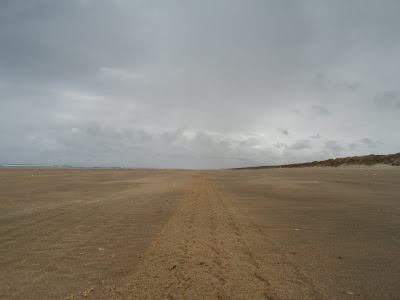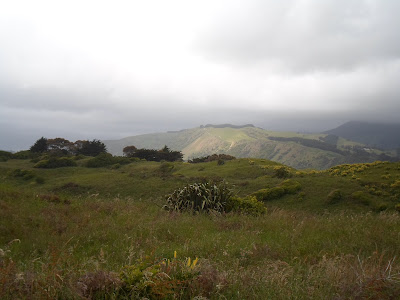In Whangarei I started talking to some Germans girls. We all were traveling in the same direction and one of them had a car. So we decided to travel further up north together. I say German 'girls' but ladies is perhaps more appropriate. Martina is 39 and Biggi is 32. We took the slow scenic back road to the Bay of Islands and that was a very good idea. It took us perhaps 3 times as long as going over state highway 1 but that didn't matter since we were riding from bay to bay on a beautiful day. Each bay was more beautiful than the one we were at before and there were almost no people on the road or on the beaches.
After a while we arrived in Russell, formerly known as 'the hell hole of the Pacific'. It used to be a harbour where wailers and other seafarers in the early days of New-Zealand came ashore after a few months at sea to blow their wages on rum and prostitutes. Now Russell is a small and quiet village full of old wooden houses. A lot of tourists take the passenger ferry from Paihia (the present day hell hole of the Pacific) for a day trip in Russell so it gets busy during the day but after the last ferry has gone it's nice and quiet in Russell. We stayed in a very small and cosy hostel overlooking the bay and I decided to stay a few days in Russell. The German ladies were travelling on, further north. I was actually pretty happy to stay behind. The Germans were nice company but they traveled way to slow for me. They were only in New-Zealand for a few days and everything was still wonderful to them. They could spend hours looking at Pohukukawa trees and Fantail birds like the are some kind of world wonder. Yeah, they are beautiful but you'll see them every day, no need to stop 10 minutes and take pictures of every bird you meet. So I stayed in Russell and walked on my own pace through the bush and on the beaches of the beautiful Bay of Islands.
I could only stay in Russell for 3 nights, the hostel is very small and was booked out from the week before Christmas to somewhere in January I had no choice but to move to Paihia, on the other side of the bay. Paihia is much more crowded than Russell. All the tourist buses pull over in Paihia and it is the main departure for boat cruises in the Bay of Islands. It has a lot of bars and a lot of backpackers who party their way through New-Zealand and lay on the beach all day fighting their hangover. Not my kind of people. But luckily I found a less party orientated hostel and I can stay until Christmas.
Everybody eventually comes to Paihia, I met a few people again who I knew from other hostels and it was nice to see them again. But there isn't that much to do besides sunbathing. But I make the most of it. I did a few walks, went digging for shellfish to have a free dinner and I rode a bike to Kerikeri to buy fresh avocados, straight from the farmers. Kerikeri is only 23km away but the weather and the landscape make it a hard job to get there. I also took a bus tour to Cape Reinga, the northernmost point of New-Zeeland. The landscape over there is very beautiful. To get there we drove over 90 Mile Beach, which is actually classified as a highway and I surfed down a massive sand dune on a body board. Heaps of fun!
Elliot Bay, en route to Russell
Tapeka Point
A little Hobbit waiting for the sun to set
Sunset over the Bay of Islands

















































